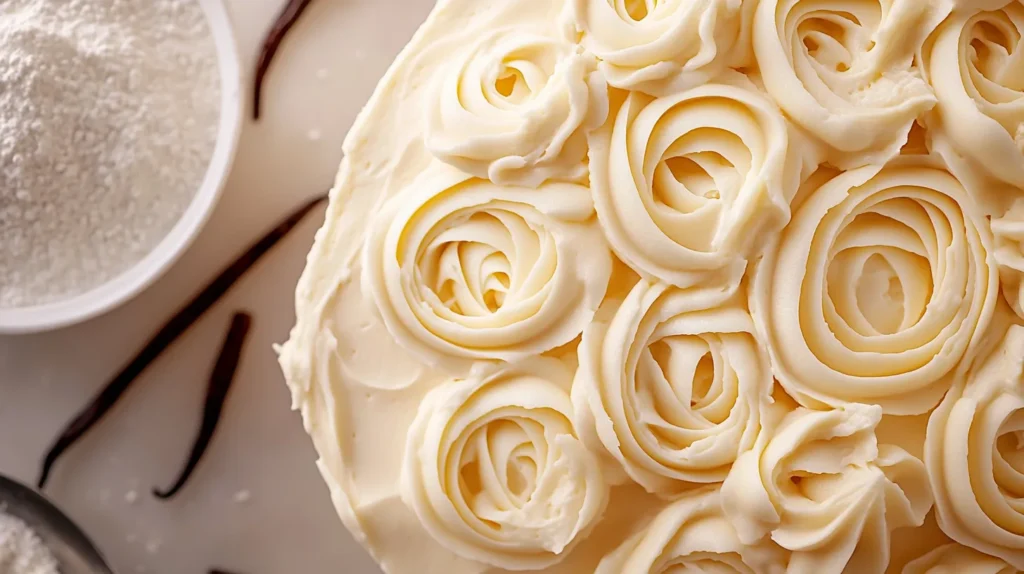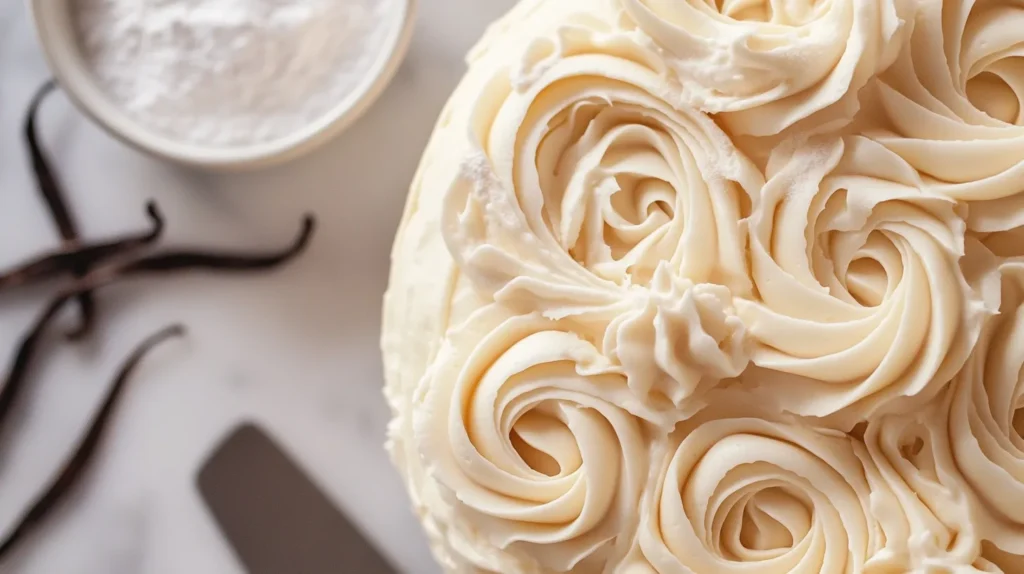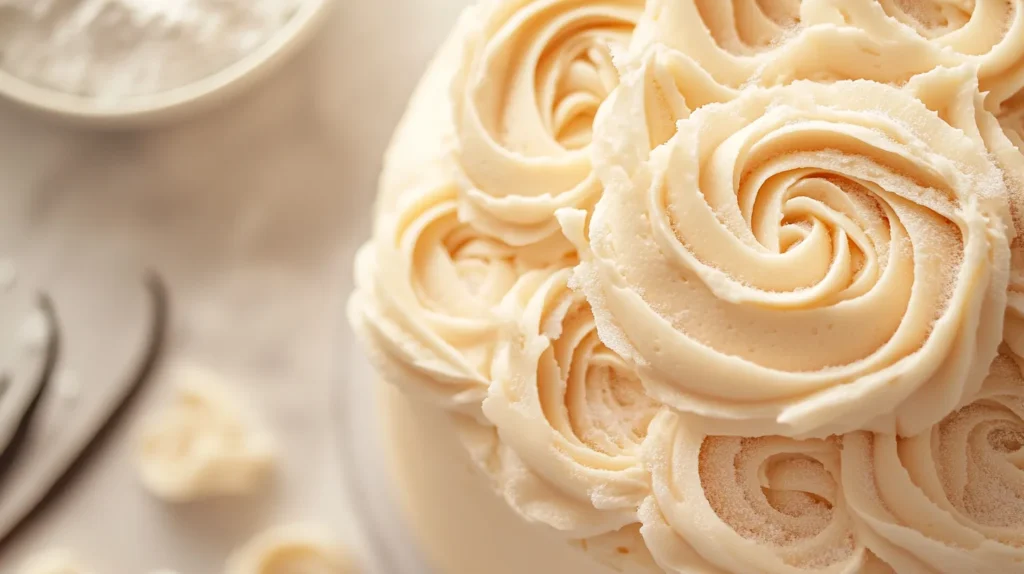Julia Child Buttercream Recipe: A Timeless Delight
The Julia Child Buttercream Recipe shines as a testament to the elegance and richness that can be achieved in dessert making. Julia Child, an iconic figure in American culinary history, revolutionized home cooking with her approachable style and dedication to quality ingredients. This article delves deep into the world of buttercream, exploring its significance, preparation, and applications, all through the lens of Julia Child’s beloved recipe.
The Art of Julia Child’s Buttercream Recipe
Introduction to Buttercream
Buttercream is more than just a sweet topping for cakes; it represents a delicate balance of flavors and textures that can elevate simple desserts to extraordinary heights. The journey of buttercream begins with its historical roots, which span many cultures and continue to evolve even today.
Background of Buttercream in Baking
Buttercream, by definition, is a rich frosting made primarily from butter and sugar, often enhanced with various flavors and colorings. Its origins can be traced back to Europe in the 19th century, where it quickly became a favored choice for frosting cakes and pastries. Over the years, it has gained prominence not only in classic French patisserie but also in American baking culture, becoming a staple in birthday celebrations and weddings alike.
Historically, buttercream was considered a luxury item, often reserved for grand occasions due to the cost of sugar and butter. Today, it serves as a canvas upon which bakers can express their creativity, leading to numerous variations across different cuisines. From Swiss meringue buttercream to American-style buttercream, each version offers unique flavors and textures, showcasing the versatility of this sweet delight.
Julia Child: A Culinary Icon
Julia Child remains an enduring symbol of culinary excellence, marking a pivotal shift in the way Americans approach cooking. Born in 1912, she brought French cooking techniques to the forefront of American kitchens through her television shows and bestselling cookbooks. Her passion for food, combined with her approachable teaching style, made her a household name.
Her influence on American cooking cannot be overstated. She encouraged home cooks to embrace the kitchen with confidence, advocating for high-quality ingredients and traditional methods. Among her vast repertoire of recipes, her buttercream stands out, exemplifying her commitment to flavor and technique. Julia’s classic recipes have inspired countless culinary enthusiasts, reminding us that cooking should be enjoyable and fulfilling.
Ingredients for Julia Child’s Buttercream
To create a truly exceptional Julia Child Buttercream Recipe, one must focus on the quality of ingredients used. Each component plays a vital role in achieving the perfect texture and flavor profile.
Essential Components
Buttercream starts with a few essential ingredients that come together harmoniously. Understanding each element’s role will help you appreciate the artistry behind this classic recipe.
Unsalted butter: Importance and qualities
Unsalted butter is the cornerstone of any buttercream. It provides the creamy base that gives buttercream its luxurious texture. Using unsalted butter allows you to control the amount of salt in your frosting, ensuring that the sweetness is balanced perfectly.
When selecting butter, opt for high-fat content varieties, as they yield a richer flavor. Room temperature butter is crucial; it should be soft enough to cream easily but not melted. This balance will ensure that your buttercream achieves that light and fluffy texture that makes it so irresistible.
Powdered sugar: Choosing the right texture
Powdered sugar, also known as confectioners’ sugar, is the next key ingredient. Its fine texture dissolves easily, creating a smooth finish in your buttercream. When choosing powdered sugar, look for brands that contain cornstarch, as it helps prevent clumping.
Sifting powdered sugar before adding it to your butter is a crucial step. This simple act aerates the sugar, resulting in a lighter frosting. It also eliminates any lumps, ensuring a velvety consistency without graininess.
Heavy cream or milk: Enhancing consistency
Heavy cream or milk is the secret weapon that elevates your buttercream to new heights. A splash of heavy cream lends a glossy sheen and a silkier mouthfeel. If you’re looking for a lighter option, whole milk can work well too, imparting a gentle sweetness without overwhelming the flavor.
When incorporating cream or milk, do so gradually while mixing, allowing you to achieve the desired consistency. You want your buttercream to be spreadable yet firm enough to hold its shape when piped onto cakes or cupcakes.
Vanilla extract: Adding flavor depth
A splash of vanilla extract transforms your buttercream from ordinary to extraordinary. This quintessential flavor adds depth and warmth, enhancing the overall sweetness of the frosting. Opt for pure vanilla extract whenever possible, as artificial extracts can leave an unpleasant aftertaste.
Consider experimenting with other flavorings as well—almond extract, citrus zest, or even espresso powder can create delightful variations. The beauty of buttercream lies in its adaptability, encouraging bakers to get creative with their flavor profiles.
Optional Additions
While the essential components are crucial for a classic buttercream, optional additions allow for personalization and experimentation.

Flavor variations (chocolate, lemon, etc.)
Chocolate buttercream is a popular twist on the classic recipe. To achieve this, incorporate cocoa powder or melted chocolate into your mixture. Adjust the amount of powdered sugar accordingly to maintain the desired consistency.
For a refreshing lemon buttercream, add freshly squeezed lemon juice and zested peel. The acidity of the lemon brightens the frosting, creating a delightful contrast to the sweetness. Similarly, other flavors like peanut butter, mint, or coffee can be explored, enabling you to create a unique experience for every occasion.
Color options for decoration
Colorful buttercream can take your baked goods to the next level. Gel food coloring is the preferred choice for tinting buttercream since it provides vibrant hues without altering the texture. Start with a small amount, adding more until you achieve your desired shade.
Layering colors can yield stunning results, especially when piping flowers or intricate designs. Consider using natural colorants like beet juice or matcha for a healthier approach that retains the flavor integrity of your frosting.
Techniques for incorporating additional ingredients
When adding flavors or colors, it’s essential to do so thoughtfully. Gradually mix in additional ingredients to prevent disrupting the buttercream’s texture. Taste tests along the way ensure that the final product strikes the right balance of flavors.
Using a stand mixer saves time and effort during this process. The paddle attachment helps achieve a smooth and uniform distribution of flavors, ensuring that every bite is consistent.
Step-by-Step Preparation of Julia Child’s Buttercream
Creating the perfect Julia Child Buttercream Recipe involves not just following the ingredients list but also mastering the technique. The mixing process requires precision and care to achieve that coveted light and airy texture.
Preparing the Ingredients
Before diving into the preparation, gather and prepare your ingredients thoroughly. Taking the time to set everything up will make the mixing process smoother and more enjoyable.
Measuring techniques for accuracy
Accurate measurements are crucial when making buttercream. Use a kitchen scale for precise measurements, especially for powdered sugar and butter. This method eliminates guesswork and ensures consistent results.
If using cups, spoon the dry ingredients into the measuring cup without packing them down. Level off the top with a straight edge to get an even measurement. For liquids, use a clear measuring cup with graduated markings to avoid spills.
Ideal temperature for butter
The temperature of your butter plays a significant role in the mixing process. Ideally, you want your unsalted butter to be at room temperature, around 65°F to 70°F. At this temperature, the butter becomes pliable and easy to cream, allowing for the incorporation of air.
If you forget to take the butter out ahead of time, you can soften it quickly by cutting it into small cubes or microwaving it on low power for a very short duration. Avoid melting the butter completely, as this will lead to a greasy buttercream.
Tips for sifting powdered sugar
Sifting powdered sugar prior to use can make a world of difference in the texture of your frosting. It prevents clumps and yields a smoother result. Use a fine-mesh sieve or sifter, holding it over a large bowl, and gently tap or shake to sift the sugar.
This process not only ensures a silky consistency but also enhances the flavor by aerating the sugar. Plus, sifting beforehand minimizes the need to overmix later, preserving the lightness of your buttercream.
Mixing Process
With your ingredients ready, it’s time to dive into the mixing process. Here, you’ll learn how to achieve that signature buttercream texture that every baker aims for.
Creaming the butter: Techniques for success
Start by placing the room-temperature butter in the bowl of a stand mixer fitted with the paddle attachment. Beat the butter on medium speed until it becomes pale and fluffy, which usually takes about three to five minutes.
This creaming process is essential for incorporating air, resulting in a light and airy buttercream. Be patient; it’s worth taking the time to ensure that the butter reaches the right consistency. Scrape down the sides of the bowl occasionally to ensure that no unmixed butter remains.

Gradually adding sugar: How to do it properly
Once the butter is creamed, it’s time to slowly incorporate the powdered sugar. Set the mixer to a low speed and gradually add the sifted sugar in increments. This minimizes mess and prevents clouds of powdered sugar from escaping into your kitchen.
After adding a portion of the sugar, increase the speed to medium-high once the sugar is incorporated, mixing until fully combined. Repeat this process until all the sugar is added, stopping to scrape down the bowl as needed. The goal is to achieve a thick and fluffy consistency.
Incorporating cream and vanilla: Achieving the right texture
After successfully combining the sugar, it’s time to bring your buttercream to life with cream and vanilla extract. Begin by pouring in the heavy cream or milk, along with the vanilla extract. Mix on low speed until the liquid is incorporated, then increase the speed for a few seconds to ensure everything is well-blended.
The addition of cream not only enriches the flavor but also adjusts the texture. If the buttercream is too stiff, add a little more cream until you reach your desired consistency. Conversely, if it’s too runny, sprinkle in more powdered sugar until it firms up. Aim for a spreadable, yet pipeable texture.
Troubleshooting Common Issues
Even experienced bakers encounter issues while preparing buttercream. Understanding common problems can save you time and frustration.
Solutions for overly runny buttercream
If your buttercream turns out too runny, don’t panic! This can happen for various reasons, such as using soft butter or adding too much cream. The simplest fix is to add more powdered sugar gradually, mixing until the desired thickness is achieved.
Alternatively, refrigerate the buttercream for a short period to allow it to firm up, then rewhip once chilled. This method can help restore some structure without compromising the flavor.
Fixing grainy textures
A grainy texture in buttercream can stem from improperly sifted sugar or overmixing. If you find that your buttercream has a gritty consistency, try re-sifting the sugar before mixing it in again.
Another solution is to gently heat the buttercream over a double boiler while stirring continuously. This will allow the sugar to dissolve further, improving the overall texture. Allow it to cool slightly before whipping it again to regain fluffiness.
Adjusting flavors for balance
Flavor balance is essential in buttercream. If your buttercream tastes too sweet, consider adding a pinch of salt or a splash of lemon juice to cut through the sweetness. Tasting as you go allows you to adjust flavors for the perfect balance that suits your palate.
Experimenting with flavors can also open avenues for creativity. If you add too much of a strong flavor, such as almond extract, incorporating more butter and sugar can help mellow it out. Baking is about trial and error, so embrace the process!
Applications of Buttercream
Once you’ve mastered Julia Child’s buttercream, the possibilities for its application are virtually endless. It serves as a versatile companion for various baked goods, enhancing both flavor and presentation.
Frosting Cakes
Frosting cakes with buttercream is one of the most common applications, and with good reason. The rich and creamy texture pairs wonderfully with layered cakes, providing both flavor and visual appeal.
Techniques for applying buttercream to cakes
Begin by leveling your cake layers to ensure they stack evenly. Place the first layer on a cake board or plate and apply a generous dollop of buttercream on top. Use an offset spatula to spread the frosting evenly to the edges, creating a solid foundation for the next layer.
Repeat this process with subsequent layers, and once all layers are stacked, use a crumb coat—a thin layer of buttercream to seal in crumbs—before applying a final, thicker layer of frosting. This technique gives your cake a polished finish and prevents crumbs from ruining the aesthetic.
Tips for achieving a smooth finish
To achieve a pristine finish, there are a few tricks to keep in mind. After frosting the cake, use a bench scraper or an offset spatula dipped in hot water to smooth the buttercream sides. Wipe the tool clean between swipes for a flawless appearance.
If you’re feeling adventurous, consider adding decorative elements such as sprinkles, edible glitter, or fresh fruits atop the finished cake. These accents can transform a simple cake into an eye-catching centerpiece.
Popular cake pairings with buttercream
Buttercream pairs beautifully with various cake flavors. Classic combinations include vanilla buttercream on yellow cake, chocolate buttercream on rich chocolate cake, and fruity buttercream on lemon or carrot cake. Experiment with different flavors and textures to discover your personal favorites.
Cupcake Decorations
Cupcakes provide another delightful canvas for buttercream artistry. With endless opportunities for decoration, they can become mini masterpieces that cater to any occasion.
Techniques for piping buttercream on cupcakes
Piping buttercream onto cupcakes is a fun and creative way to showcase your skills. Equip yourself with a piping bag and a variety of piping tips to create different designs, such as swirls, rosettes, or stars.
Fill your piping bag with buttercream and hold it at a 90-degree angle above the cupcake. Apply steady pressure and move your wrist in a circular or upwards motion to create your desired design. Practice makes perfect, so don’t hesitate to experiment with different techniques.
Ideas for creative designs and themes
Cupcakes lend themselves to themed decorations, whether for birthdays, holidays, or special events. Consider using colored buttercream and sprinkles to match party themes. Seasonal themes, like pastel colors for spring or warm hues for fall, create a festive touch.
You can also add toppings like fruit slices, chocolate shavings, or edible flowers for an elegant finishing touch. The key to innovative designs lies in letting your imagination run wild!
Storing decorated cupcakes for freshness
Keeping your decorated cupcakes fresh is vital for maintaining their flavor and aesthetics. Store cupcakes in an airtight container at room temperature for up to two days. For extended storage, refrigerate them, but note that cold temperatures can harden buttercream.
If decorating in advance, consider storing the cupcakes without a final layer of buttercream, applying it just before serving. This will preserve the texture and taste, ensuring that your cupcakes remain delightful treats for your guests.

Other Uses in Desserts
Beyond cakes and cupcakes, buttercream finds its way into an array of delectable desserts, enriching flavors and textures in unexpected ways.
Buttercream works exceptionally well as a filling for pastries and cookies. Whether sandwiched between two cookies or used to fill éclairs, it adds a creamy, sweet surprise that complements the baked goods beautifully.
For cookie sandwiches, consider flavored buttercreams to match the cookies. Chocolate buttercream paired with chocolate cookies creates a luscious treat, while vanilla buttercream works wonders with oatmeal or sugar cookies.
Layering in desserts like trifles
Layering buttercream in desserts like trifles introduces a delightful combination of textures. Alternate layers of crushed cake, fruit, and buttercream in a glass dish for an eye-catching presentation.
The harmony of flavors and textures creates an indulgent dessert that’s perfect for entertaining. Personalize trifles with seasonal fruits and assorted cake flavors for diverse offerings that cater to various tastes.
Use in cake pops and other confections
Buttercream serves as an excellent binder for cake pops, transforming leftover cake into bite-sized treats. Crumble leftover cake into a bowl and mix it with buttercream until pliable. Shape into balls, dip in chocolate, and decorate with sprinkles for a fun and delightful snack.
Incorporate buttercream into other confections, such as brownies or bars, for added creaminess. The versatility of buttercream allows it to enhance numerous desserts, making it a baker’s best friend.
Frequently Asked Questions (FAQ)
How Do I Make Sure My Buttercream is Smooth?
To make smooth buttercream, start by ensuring your butter and egg whites are at room temperature, as cold ingredients can cause graininess or curdling. Next, cook the sugar syrup to 240°F (115°C) to achieve the correct consistency. If your buttercream looks curdled, keep mixing until it smooths out. If needed, gently heat the bowl over warm water to help it come together. Furthermore, using a fine mesh sieve to strain any lumps can also ensure a silky texture. By following these steps, you’ll achieve a smooth and flawless buttercream. Patience and attention to detail are key.
Can I Use This Buttercream for Piping Flowers?
Yes! Julia Child’s buttercream is firm enough to hold intricate piping designs, making it perfect for cake decorations, including flowers, borders, and other detailed work.
Can I Make This Recipe Dairy-Free?
While this recipe(Julia Child Buttercream Recipe) relies on butter for its flavor and texture, you can substitute it with dairy-free alternatives like margarine or vegan butter. However, the texture may vary slightly.
How Can I Fix Grainy Buttercream?
If your buttercream turns out grainy, it may be due to undissolved sugar or the syrup being too hot. Gently reheat the mixture while mixing to melt any sugar crystals. You can also strain the buttercream to remove any lumps.
How Long Can I Store Julia Child’s Buttercream?
You can store Julia Child Buttercream Recipe at room temperature for up to 2 days, or refrigerate it for up to 5 days. If you freeze it, it can last up to 3 months. Make sure to let it come to room temperature before using and give it a quick mix to restore its smooth texture.
Conclusion
Julia Child’s contributions to the culinary world extend far beyond her famous recipes; she sparked a movement that continues to inspire home cooks and professional chefs alike. The Julia Child Buttercream Recipe is a cherished example of her philosophy—embracing quality ingredients and timeless techniques to create beautiful, delicious desserts.
As we explore the rich history and various applications of buttercream, we celebrate the artistry involved in baking. So whether you’re frosting a cake, decorating cupcakes, or filling pastries, remember that the process is just as important as the end result. Embrace the joy of baking, and let your creativity shine through in every bite!
In the spirit of Julia Child, let us encourage ourselves to experiment and enjoy the delightful process of baking. After all, the sweetest memories are often created in the kitchen!
If you’re looking for a dessert that combines rich flavors and indulgence, consider trying Reese’s Caramel Cheesecake. Its creamy texture and the perfect balance of caramel and peanut butter will be a hit at any gathering.
Print
Julia Child Buttercream Recipe: A Timeless Delight
- Total Time: 25 minutes
- Yield: Enough for 1–2 cakes or 12 cupcakes 1x
Description
The Julia Child Buttercream is a classic French buttercream that is rich, creamy, and perfect for frosting cakes or cupcakes. It’s made with butter, egg yolks, and sugar, creating a silky-smooth texture that’s slightly less sweet than American buttercream, allowing the flavor of the cake to shine through. This versatile frosting can be flavored with vanilla, chocolate, or other extracts, and is sure to impress anyone with its decadent taste.
Ingredients
- 1 cup unsalted butter, softened
- 1 cup granulated sugar
- 1/4 cup water
- 4 large egg yolks
- 1 1/2 teaspoons vanilla extract
- Pinch of salt
Instructions
-
Prepare the Sugar Syrup:
- In a small saucepan, combine the granulated sugar and water. Heat over medium heat, stirring until the sugar is dissolved. Increase the heat and bring to a boil, then let it boil for about 2-3 minutes until it reaches 240°F (115°C) on a candy thermometer. Remove from heat.
-
Whisk the Egg Yolks:
- While the sugar syrup is heating, beat the egg yolks in a stand mixer or large mixing bowl with a hand mixer until they become pale and thick.
-
Combine Syrup and Egg Yolks:
- Once the sugar syrup reaches 240°F, slowly and carefully pour the hot syrup into the egg yolks while beating at a medium speed. Be cautious, as the syrup is extremely hot. Continue beating until the mixture cools to room temperature and thickens.
-
Add the Butter:
- Gradually add the softened butter, a tablespoon at a time, beating continuously until the buttercream is smooth and creamy. Once all the butter has been incorporated, add the vanilla extract and salt, then mix until fully combined.
-
Use or Store the Buttercream:
- The buttercream is now ready to be used to frost cakes, cupcakes, or cookies. If you’re not using it immediately, store it in the refrigerator. Before using, let it come to room temperature and re-whip to restore its smooth texture.
Notes
- You can flavor the buttercream by adding cocoa powder for chocolate buttercream or other extracts like almond or lemon.
- This buttercream works best when the ingredients are at room temperature, so make sure to leave the butter and eggs out for a little while before starting.
- If the buttercream becomes too soft, refrigerate it for a few minutes and re-whip to firm it up.
- Prep Time: 15 minutes
- Cook Time: 5 minutes
- Category: Dessert, Frosting
- Method: Whisking, Cooking
- Cuisine: French
Nutrition
- Serving Size: 1 tablespoon
- Calories: 100
- Sugar: 10g
- Sodium: 25mg
- Fat: 7g
- Saturated Fat: 4g
- Unsaturated Fat: 3g
- Trans Fat: 0g
- Carbohydrates: 11g
- Fiber: 0g
- Protein: 0g
- Cholesterol: 30mg
Keywords: Julia Child Buttercream, French Buttercream, Cake Frosting

